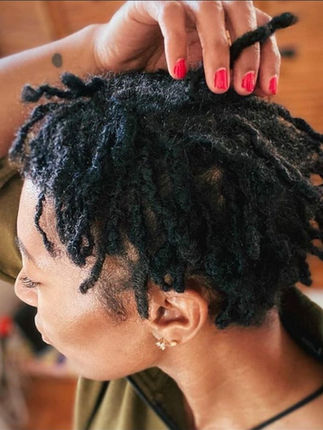The Stages of Locs
Just as as people do, locs evolve and change as they grow to maturation. Get to know the 4 stages of locs.
Starter
(0-3 Months)
Starter locs are the initial stage of one’s loc journey. They are formed by gathering loose hair into sections of varying size (depending on preference) and manually reinforcing the natural process of tangling, matting, and encasing to eventually form a mature loc.
Starter locs tend to be neat, uniformed and smooth, but are prone to unraveling. There are various methods for installing starter locs such as comb coils, two-strand twist, interlocking, and braids. Note: There is no specific hair type or length requirement for starter locs .
During this time regular maintenance is required and excessive manipulation should be avoided. Let your hair naturally transition through the four stages to maturation.
In addition to installation method, also consider your preferred parting pattern. The most common patterns are grid, brick, natural, diamond and triangle. See loc glossary definitions.
Budding
The budding stage, also known as “sprouting”, is the second stage of locs. The timeline for budding will vary by individual based on hair texture, length, density, and thickness. In this stage, the budding loc will be smooth and uniformed at the root until the mid shaft at which point small knots or buds begin to take shape. It is common for some sections to be loose while others start to form tighter knots and bumps.
The locs will swell and almost double in size and look thicker and frizzy, giving a somewhat puffy appearance. The budding stage is quite unique and very important as you transition to mature locs. It is essential to take proper care and maintenance during this stage as it will set a strong foundation for healthy well-formed locs. Regular maintenance is recommended to ensure your locs are being cultivated and nurtured appropriately. However, avoid excessive twisting and manipulation as this can lead to breakage and thinning.
(4-7 Months)
Teenage
Once your hair has fully budded across the entire length of the loc and swelled to almost twice it’s original size, you are in the teenage stage. This period is characterized by unruly semi-formed locs that typically do not lay flat. They tend to stick up and out in various directions in defiance of being refined of controlled. Their headstrong and rebellious nature lends itself to the name “teenage” where the hair seems to have a mind of its own.
This tumultuous and unpredictable stage is also dubbed as the “ugly” stage. While LNB does not subscribe to this idea, it is a popular comment that reflects how people feel as they managing through this stage. We suggest experimenting with pressure styles, such as rope twists and curly sets, to help control and tame some of the "wildness".
During this time you may also feel like your locs are shrinking or not growing lengthwise. This illusion is due to your locs becoming more dense because of the transformation that’s happening inside of the shaft.
(8-15 Months)
Mature
(16-24 Months +)
The mature stage of locs, often referred to as the "adult" stage, is when your locs have fully formed and are well-established. This typically occurs after 1.5 to 2 years of consistent maintenance, though it can vary depending on hair type, the method used to start your locs, and how well your locs have been cared for.
At this stage, your locs are firm and solid from root to tip and have lost most of the puffiness and frizz that is common in the earlier stages. The tips of the locs are often blunted or rounded, especially if they were maintained with palm rolling or crocheting techniques. However, some locs may have loose or curly ends, depending on the natural curl pattern of the hair and the method used during installation. While everyone’s locs are unique, typically each loc has a consistent diameter along its length, although the thickness will vary depending on the original size of the parted sections your started with.
With the exception of freeform or semi-freeform locs, the overall look is neat and defined that gives the locs a mature, uniformed appearance.







